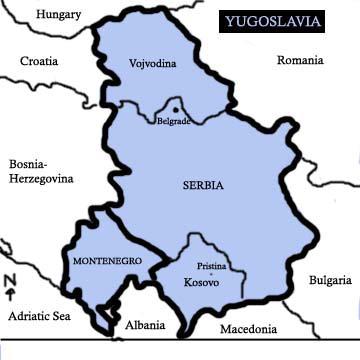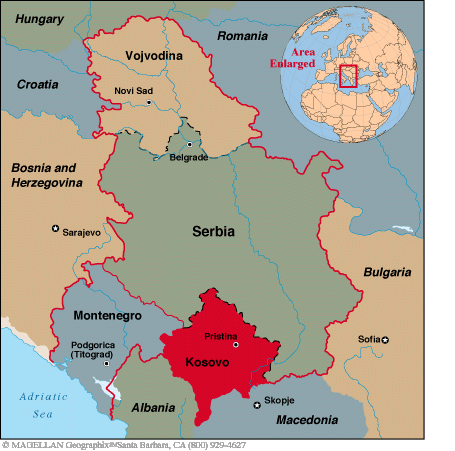Places I saw and recommend in Kosovo: Prizren and the mountains near the Albanian border.
How Serbia is similar to Oklahoma
 In 1974, Serbia became like Oklahoma. Most Yugoslavs were not happy with the centralized economy and they thought decentralization would fix things. To avoid a revolt, Tito agreed to increase everyone's autonomy. Among the five republics, Serbia was the only one to have two autonomous provinces carved out of it: Vojvodina in the north and Kosovo in the south. Albanians were begging Tito for republic status, but Tito picked the compromise solution: autonomy. As a result, Serbia turned into Oklahoma.
In 1974, Serbia became like Oklahoma. Most Yugoslavs were not happy with the centralized economy and they thought decentralization would fix things. To avoid a revolt, Tito agreed to increase everyone's autonomy. Among the five republics, Serbia was the only one to have two autonomous provinces carved out of it: Vojvodina in the north and Kosovo in the south. Albanians were begging Tito for republic status, but Tito picked the compromise solution: autonomy. As a result, Serbia turned into Oklahoma.
Oklahoma, along with several other western US states, has large Native American reservations within it. Although the US has 50 states, there are about 310 autonomous Indian reservations within them.
In the map below highights the autonomous Indian reservations. Oklahoma is the state in the middle with blue colored reservations representing the Cherokee Nation. Mouse over the image to zoom in. Or view the high resolution version.
These autonomous regions are similar to Serbia's two autonomous provinces:
- Indian Tribes have their own government, their own laws, and a separate court system.
- They handle all Indian-on-Indian crimes, but if a non-Indian is involved, it usually goes to the federal courts.
- They are only subordinate to the US federal government, not to the state government.
- In other words, Oklahoma cannot tell a tribal land to do anything.
- Only the federal government has any authority—and that authority is minimal.
- The US Constitution specifically protects "Indian tribes" by saying that they are neither part of a state nor part of the federal government.
- The Federal government cannot tax the Native American regions; they collect their own taxes.
- The Tribal Lands have the power to expel non-Native Americans from their reservations.
US states have often tried to control the tribes, but the US Supreme Court has always said that the tribes must work directly with the federal government and that the states have no power over the tribal lands.
Now imagine that the US were breaking apart into separate countries:
- Florida becomes a Spanish-speaking country.
- Texas becomes the Lone Star nation.
- Alaska and Hawaii declare independence and join the UN.
- California does the same.
- New England states join together to form one country, and so on.
During such a disintegration, what would the Cherokee Tribe in Oklahoma do? Would they join the new country of Oklahoma? Or perhaps, would they say, "Sorry, we've always been autonomous, so we're declaring our own separate independence. We're now the Cherokee Nation."
If so, then Oklahoma protesters might say, "The Cherokee Territory is Oklahoma. It's been part of Oklahoma for the last 100 years. We refuse to recognize your independence and we'll go to war with you if you try to break away from us."
This is a similar situation that Yugoslavia set itself up for with its 1974 Constitution. Because it was a compromise, neither the Albanians nor the Serbs were happy with it. Serbs lamented being "butchered" into three pieces.

Meanwhile, Albanians disliked not having republic status. Albanians observed that there are over three times as many ethnic Albanians in Kosovo than there are ethnic Montenegrins in Montenegro, yet Montenegro was a republic and Kosovo was not. In fact, ethnic Montenegrins were only 40 percent of Montenegro, whereas Albanians had been over two-thirds of Kosovo for at least 100 years. "So why can't we be a Yugoslav republic?" Albanians cried.
On the other hand, the only real difference between an autonomous region and a republic was the name. As the 1986 Memorandum stated, "Autonomous provinces were put on an equal footing with the republics in all respects . . . ." After Tito's death, Kosovo's President served as one of Yugoslavia's eight rotating Presidents. Milošević referred to how much power Kosovo had when he complained about Kosovo's anti-Serb policies by saying, "The Albanians could do this because the province of Kosovo was virtually a republic. The local council had the power to implement what I'd call a truly Nazi policy."
Given the minor difference between a republic and an autonomous province, why did Albanians make such a fuss about being upgraded to a republic? The main reason was about respect and symbolism. Kosovo had a strong identity just like similar sized (or smaller) republics like Slovenia, Macedonia, and Montenegro, so it should have the same status.
A less obvious reason—but one that would become critical when Yugoslavia broke up—was that republics ultimately had the right to leave Yugoslavia, while autonomous provinces did not. It's not clear how important that argument was for Albanians in 1974, but it explains why Kosovo's road to independence has been much harder than for the seven republics.
This is an excerpt of The Hidden Europe: What Eastern Europeans Can Teach Us. You might want to read my initial impressions of Kosovo in 2004. My opinion on Kosovo evolved after my second visit in 2009, which I talk about in my book. You should also download and listen to my WanderLearn podcast about Serbia. You might want to read about when I first visited Serbia in 2004. And read Serb comments about the chapter on Serbia.
Recommended reading
Read up about Kosovo in Wikipedia and Kosovo in the CIA Factbook.
Travel deals to Kosovo
Check my favorite travel sites:
Interactive map of Kosovo
View Larger Map





